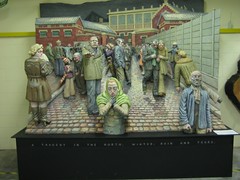Just yesterday I was rereading Raymond Mason's collected writings, At Work in Paris: now ,today I opened my newspaper to read the sad news of his death in Paris on 14 February. He was utterly unique and there was no one remotely like him on the UK or French art scene.
Mason is an artist who interests me because he had a highly original view of sculpture and was an excellent draughtsman.That he was also an excellent writer/speaker is also evident from the book I mentioned.I took it up because I wanted to refresh my image of Henry Moore whom Mason knew. Moore comes across as a genial but sometimes pompous soul who is concerned for his status and obviously saw himself as the leader of the first eleven of UK sculpture. Given the way many of his acolytes developed this was not necesarilly a good thing.
This contrasts with the line being put forward by theTate Britain who are trying to stress a darker more disturbing side to Moore's work. I don't see it myself and I will need some convincing for it seems to me that the curator has let his imagination run away with him and manufacturing something which cannot reasonably be found. Compared to Miro, Masson or Picasso he is far too genteel and the post war work of Moore is not evidence of a great old age.
But let me praise Mason for his remarkable drawings of townscapes and human anatomy. Let me also praise him for his willingness to make sculptures which deal with the disasters and sadness of contemporary life. The sculpture of the Tragedy in the North (the aftermath of a mining disaster) is too much in 3D to be called a relief and it is painted in the colours of life. I have often thought it grotesque and clumsy but even if that is the case it has a Hogarthian vigour which is unusual nowadays. My preference is for the earlier reliefs such as theBarcelona Tram .
Let me finish by mentioning some of the other texts in Mason's book. There is a beautiful essay on Cartier-Bresson -Mason seems to have known everyone in Paris - which describes Mason's experiences as sitter and observer of the photographer at work. There is a memoir of Dubuffet which is striking to say the least. He appears as very intelligent, generous,mercurial and irascible.There are also texts on Picasso, Giacometti,Balthus and various important dealers. Regarding Giacometti we find that Mason approves of James Lord's biography-his opinion differing from that of Sylvester.
At Work in Paris by Raymond Mason, Thames & Hudson 2003
Mason is an artist who interests me because he had a highly original view of sculpture and was an excellent draughtsman.That he was also an excellent writer/speaker is also evident from the book I mentioned.I took it up because I wanted to refresh my image of Henry Moore whom Mason knew. Moore comes across as a genial but sometimes pompous soul who is concerned for his status and obviously saw himself as the leader of the first eleven of UK sculpture. Given the way many of his acolytes developed this was not necesarilly a good thing.
This contrasts with the line being put forward by theTate Britain who are trying to stress a darker more disturbing side to Moore's work. I don't see it myself and I will need some convincing for it seems to me that the curator has let his imagination run away with him and manufacturing something which cannot reasonably be found. Compared to Miro, Masson or Picasso he is far too genteel and the post war work of Moore is not evidence of a great old age.
But let me praise Mason for his remarkable drawings of townscapes and human anatomy. Let me also praise him for his willingness to make sculptures which deal with the disasters and sadness of contemporary life. The sculpture of the Tragedy in the North (the aftermath of a mining disaster) is too much in 3D to be called a relief and it is painted in the colours of life. I have often thought it grotesque and clumsy but even if that is the case it has a Hogarthian vigour which is unusual nowadays. My preference is for the earlier reliefs such as theBarcelona Tram .
Let me finish by mentioning some of the other texts in Mason's book. There is a beautiful essay on Cartier-Bresson -Mason seems to have known everyone in Paris - which describes Mason's experiences as sitter and observer of the photographer at work. There is a memoir of Dubuffet which is striking to say the least. He appears as very intelligent, generous,mercurial and irascible.There are also texts on Picasso, Giacometti,Balthus and various important dealers. Regarding Giacometti we find that Mason approves of James Lord's biography-his opinion differing from that of Sylvester.
At Work in Paris by Raymond Mason, Thames & Hudson 2003


